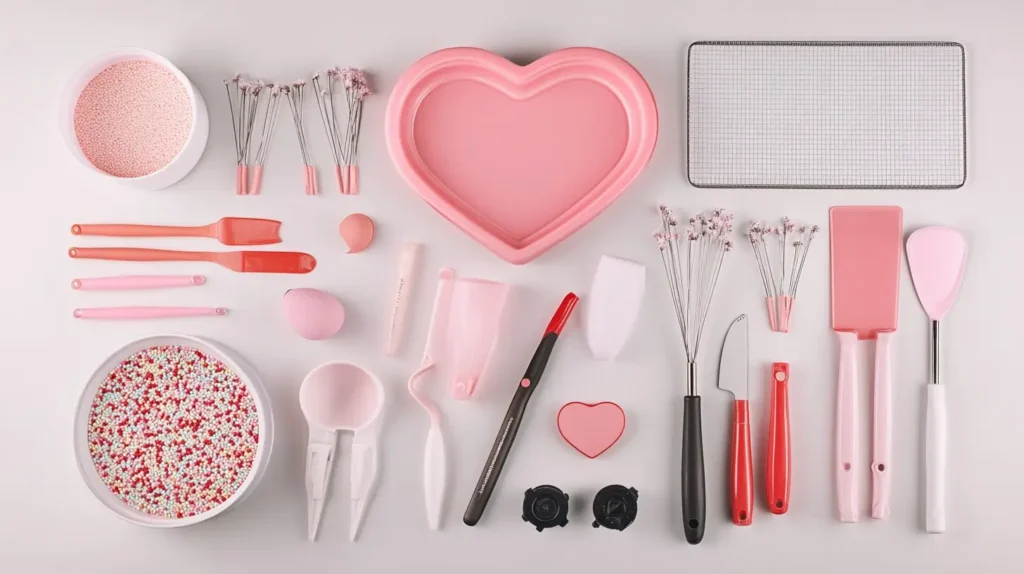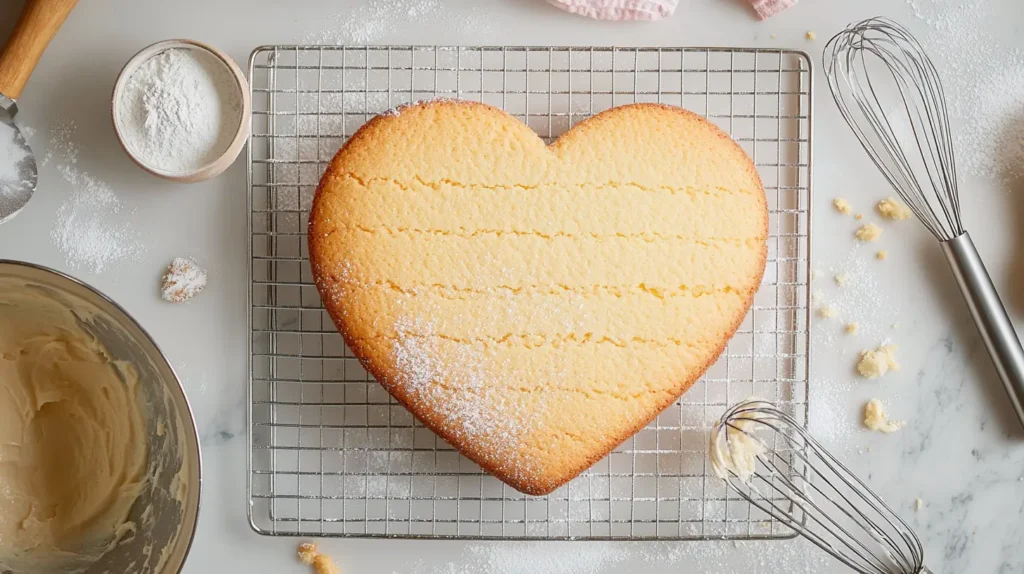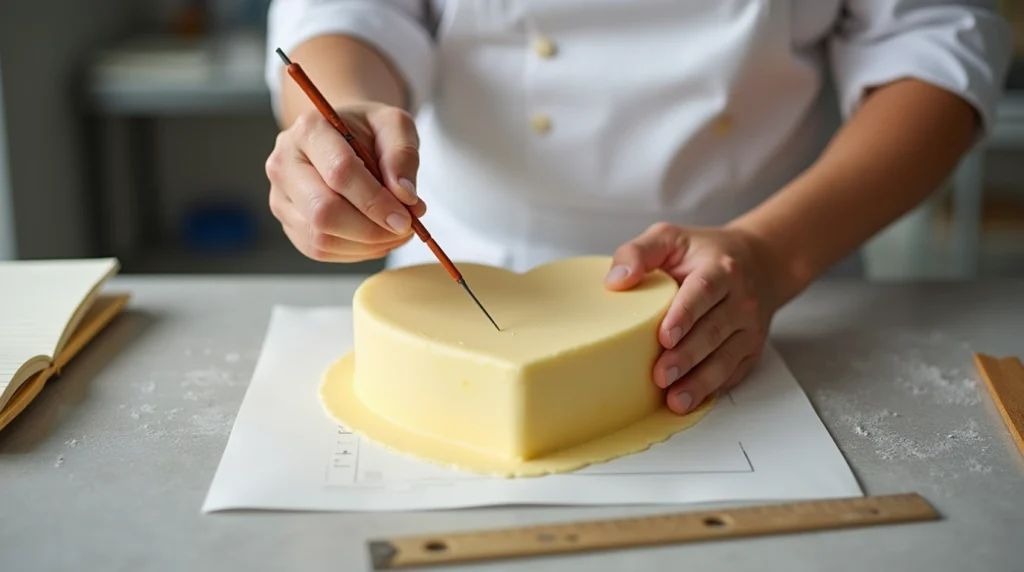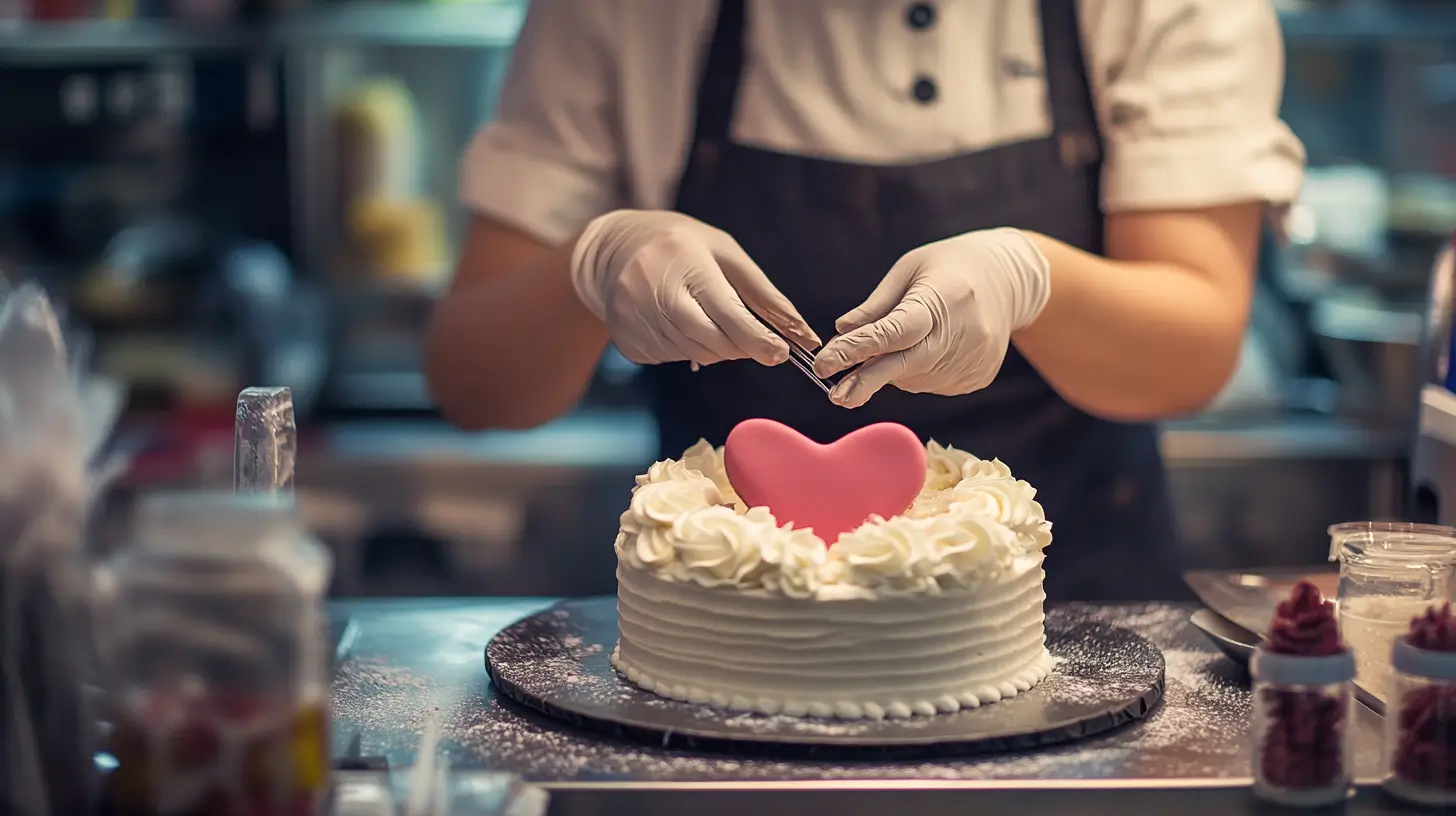A perfect heart shape cake seems impossible to make at first. Many skilled bakers face challenges with uneven sides and collapsed centers. Their results often look misshapen. But the heart cake boss approach changes everything and turns these common problems into consistent wins.
The basics of cake structure will help you become skilled at making heart shaped cakes and heart confections. A picture-perfect heart shaped cake needs exact measurements and proper temperature control. You can learn these specialized techniques with ease. This complete piece guides you through each key step. You’ll learn about picking the right tools and fixing common problems. Your heart cakes will turn out flawless every time.
Table of contents
The Science Behind Perfect Heart-Shaped Cakes
The science of creating perfect heart-shaped cakes begins with mastering the delicate balance between ingredients, temperature, and baking techniques. Achieving the right texture, moisture, and structure requires understanding how key elements interact during the baking process. Whether you’re a beginner or an experienced baker, refining these skills will help you produce heart cakes that look stunning and taste incredible.
The right ingredient ratios play a crucial role in cake consistency. Using high-quality butter, fresh eggs, and the correct amount of sugar and flour ensures a well-balanced batter. The addition of leavening agents like baking powder or baking soda creates a light, fluffy texture, while liquids such as milk or buttermilk contribute to moisture and richness.
Temperature control is another essential factor in perfecting heart cakes. Preheating the oven to the correct temperature prevents uneven baking, while properly creaming butter and sugar at room temperature helps create a smooth, airy batter. Avoiding extreme temperature fluctuations, such as opening the oven door too frequently, helps maintain a stable baking environment.
By mastering these elements, you’ll achieve professional-quality heart cakes that rise evenly, hold their shape, and have a tender crumb. Every heart cake boss knows that success comes from precision, patience, and the right techniques—turning a simple cake into a masterpiece.
Understanding cake geometry and structure
A successful heart shaped cake’s foundation lies in its molecular structure. The proteins glutenin and gliadin combine to create gluten strands that provide structure when flour mixes with liquid ingredients. These strands work with other ingredients to create a network that traps air bubbles and gives your cake its desired texture.
Your core ingredients’ interaction determines the final structure. Sugar does more than add sweetness – it creates tender crumbs and helps lock in moisture. Eggs are vital binding agents that bring your batter together and help the cake rise properly.
Essential measurements and proportions
Precise measurements make a perfect heart shape cake. Room temperature ingredients will give a proper mix. Cold ingredients can lead to poor distribution and affect your cake’s final texture.
Here’s what happens when temperature affects your mixing process:
- Room temperature ingredients (70°F) create a smooth, well-emulsified batter
- Cold ingredients (40°F) result in butter clumps and thin batter
- Warm ingredients (80°F) produce an unstable mixture that affects the final texture
Temperature control fundamentals
Temperature management shapes your cake’s success. Your oven temperature affects how the cake rises and its final texture. The Maillard reaction begins when baking temperatures exceed 300°F – this creates that desirable golden-brown crust.
Temperature control requires attention to these factors:
- A 10-15 minute preheat gives you stable temperature
- Temperature fluctuations of 8-10°C happen normally during baking
- Higher humidity needs longer baking times or temperature adjustments
Even heat distribution matters most for heart shaped cakes. You might need to lower your oven temperature if you notice uneven baking. This helps prevent overcooking the outside while the inside bakes properly.
Professional Tools and Equipment Essentials
Professional-quality heart-shaped cakes require more than just basic kitchen tools. Achieving bakery-level results depends on having the right professional equipment to ensure precision, consistency, and flawless presentation. Whether you’re a home baker looking to improve your skills or an experienced decorator aiming for perfection, investing in the proper tools will elevate your heart cakes to the next level.
A high-quality heart-shaped cake pan is essential for creating a well-defined shape. Opt for a non-stick, heavy-duty pan that distributes heat evenly, preventing overbaked edges and undercooked centers. If you plan to make multi-tiered cakes, sturdy cake boards and dowels provide the necessary support for a stable structure.


For smooth and professional-looking frosting, a cake turntable allows for effortless decorating, while an offset spatula helps achieve even layers of buttercream or ganache. Piping bags with a variety of nozzles enable intricate detailing, from delicate rosettes to elegant borders. A fondant smoother is also a must-have if you prefer sleek, polished cake finishes.
Precision is key in professional baking, so using digital kitchen scales, accurate measuring cups, and an oven thermometer ensures consistent results every time. A stand mixer or hand mixer will also make mixing batter and whipping frosting much easier and more efficient.
By equipping your kitchen with these professional tools, you’ll be able to create heart-shaped cakes that not only taste amazing but also have the flawless presentation of a bakery-quality masterpiece.
Must-have cake shaping tools
Perfect heart-shaped confections need these vital tools:
- Professional-grade pastry bags with many tips for detailed work
- Canvas bags for heavy batters and cookie dough
- Polyurethane bags for buttercream work
- Heart-shaped cake pans with non-stick surfaces
Cake Boss Bakeware collections come in three distinct levels – simple, deluxe, and professional – each matching different skill levels and needs. The professional line features durable aluminized steel with special quilting patterns that promote even heating.
Temperature monitoring devices
Precise temperature control separates good results from exceptional ones. An instant-read digital thermometer becomes your reliable ally when checking batters and buttercream temperatures. A dedicated oven thermometer helps maintain consistent baking temperatures, since even modern ovens can develop temperature variations.
Temperature probes can track your oven’s performance continuously at the professional level. These devices help your creations maintain perfect consistency, since exact oven temperatures are vital for properly baking breads, cookies, and heart shaped cakes.
Professional-grade mixing equipment
A commercial mixer is the life-blood of any serious baking operation. These powerful machines handle everything from mixing batters to whipping eggs and kneading dough efficiently. On top of that, planetary mixers complete mixing tasks faster than hand mixing while ensuring consistent results.
Your mixing equipment should include:
- A sturdy stand mixer with paddle, whip, and hook attachments
- Multiple mixing bowls in various sizes
- Silicone grips for comfortable handling
The professional line of mixing equipment features commercial-quality carbon steel construction with rolled edges that provide strength and durability. These tools streamline processes and ensure consistent results that set professional-quality heart shaped cakes apart from amateur attempts.
Mastering the Perfect Cake Base
The perfect heart-shaped cake begins with mastering the fundamentals of a well-structured cake base. While creativity in decorating is important, the foundation of any great cake lies in its texture, flavor, and consistency. Achieving a flawless heart cake depends on three key elements: quality ingredients, proper mixing techniques, and precise moisture control.
Using high-quality ingredients makes a significant difference in both taste and texture. Fresh eggs provide structure, real butter enhances richness, and premium flour ensures a light yet sturdy cake. Choosing the right type of sugar and leavening agents like baking powder or baking soda also affects the cake’s final rise and softness.


Proper mixing techniques are equally important. Overmixing can lead to a dense or tough cake, while undermixing may result in uneven texture. Start by creaming butter and sugar until light and fluffy, then gradually incorporate dry and wet ingredients to maintain an airy batter. Mixing just until combined prevents overworking the gluten, ensuring a tender crumb.
Moisture control is the final element that guarantees a perfectly baked cake. Ingredients like buttermilk, sour cream, or oil can help maintain softness, while precise baking times prevent dryness. Monitoring oven temperature with a thermometer and avoiding frequent door opening will ensure even baking and consistent results.
By mastering these three essential elements, you’ll create a heart-shaped cake that is not only visually stunning but also irresistibly delicious, making it the perfect treat for any special occasion.
Ingredient selection and quality
Premium ingredients make much difference in your final creation. Your cake’s foundation relies heavily on these core components:
- Cake flour (creates proper structure and tender crumb)
- Organic dairy products (for superior taste and texture)
- Room temperature eggs (for better binding)
- Pure vanilla extract (never artificial essence)
- Full-fat milk (3.5% fat content for moisture)
Organic dairy products boost both taste and texture because organic farmers focus on quality rather than convenience. To cite an instance, see how adding a small amount of instant coffee intensifies the chocolate flavor without adding coffee taste in chocolate variations.
Mixing techniques for consistent results
Like a dance, proper mixing needs you to understand different methods and their purposes. Here are the main mixing techniques to achieve professional results:
| Method | Best For | Key Characteristic |
|---|---|---|
| Creaming | Standard cakes | Creates sturdy, soft texture |
| Reverse Creaming | Tiered cakes | Produces tighter, less fluffy crumb |
| Blending | Moist cakes | Results in pourable batter |
| Foam Method | Light cakes | Creates airy texture |
The creaming method works exceptionally well for heart shaped cakes and provides both structure and tenderness. Your butter and sugar need to be creamed for 3-5 minutes until light and fluffy.
Moisture control secrets
Managing moisture is significant to achieve the perfect texture. Your heart cake should contain between 17% to 25% water content for optimal results. The quickest way to maintain proper moisture levels:
- Use full-fat milk instead of reduced-fat alternatives
- Add sour cream or yogurt for extra moisture
- Monitor humidity levels during baking
- Properly measure flour using the spoon-and-level method
Keep in mind that hydrocolloids in your ingredients help absorb and hold water, creating the ideal batter viscosity. This becomes especially important when you craft heart shaped cakes that need to maintain their shape and moisture content throughout decorating and serving.
Quality Control Checkpoints
Quality control is the foundation of professional cake making, distinguishing masterful creations from amateur attempts. Every heart cake boss understands that achieving bakery-level perfection requires sharp attention to detail at every stage of the baking process. From ingredient selection to final presentation, consistency is key to producing high-quality cakes that impress every time.
The journey to a flawless heart-shaped cake starts with using the finest ingredients. Fresh, high-quality butter, pure vanilla extract, and premium flour create a more refined texture and richer flavor. Measuring ingredients accurately with kitchen scales ensures consistency in every batch, preventing issues like dry or overly dense cakes.


Precise mixing and baking techniques also play a critical role. Overmixing can lead to a tough cake, while undermixing may result in uneven texture. Using the right tools, such as a stand mixer for uniform batter incorporation and an oven thermometer for accurate temperature control, helps maintain a high standard of baking.
Once baked, a professional-level cake requires careful cooling, leveling, and decorating. A true heart cake boss ensures that every layer is even, every frosting application is smooth, and every detail enhances the overall presentation. Whether using fondant, buttercream, or intricate piping techniques, maintaining precision in decoration elevates the final product to perfection.
By prioritizing quality control and attention to detail, bakers can consistently create heart cakes that not only look stunning but also deliver exceptional taste and texture. These expert techniques separate professional results from amateur baking, ensuring that every cake is a showstopper.
Pre-baking inspections
The pre-baking checks should focus on ingredient quality and equipment readiness. Your ingredients should be at 70°F for the best mixing results. Take time to check these vital elements:
- Room temperature eggs and dairy products
- Fine-tuned oven temperature
- Clean, properly greased cake pans
- Functional temperature monitoring devices
The oven temperature needs extra attention because it will substantially affect your final product. Make sure your oven keeps a steady temperature, though variations of 8-10°C are normal.
During-bake monitoring steps
The baking process demands constant watchfulness. Your cake’s internal temperature will give a reliable quality control reading. Here’s a helpful temperature monitoring guide:
| Baking Stage | What to Check | Target Range |
|---|---|---|
| Original Rise | Edge formation | 200°F |
| Mid-bake | Internal temp | 210°F |
| Final Stage | Edge separation | 99°C |
Watch for these visual signs carefully:
- Edges pulling away from the pan
- Golden-brown surface development
- Uniform rising pattern
Post-bake quality checks
Quality assessment after baking helps maintain professional standards. The heart cake should reach an internal temperature between 200°F to 210°F.
A thorough post-bake inspection includes:
- Visual assessment of color uniformity
- Texture evaluation through gentle pressing
- Internal temperature verification
- Structural integrity check
The cake’s moisture content should stay between 17% to 25% to achieve optimal results. This range helps your heart shaped cake keep its desired texture and freshness.
Professional bakers use systematic quality control measures throughout production. These checkpoints help maintain consistency in all your heart-shaped confections. Each romantic occasion cake will meet the highest quality standards.
Troubleshooting Common Heart Cake Issues
Even expert bakers face challenges when making heart-shaped cakes. The unique shape, with its pointed edges and wider center, can lead to uneven baking, causing the edges to overcook while the middle remains underdone. To prevent this, use an oven thermometer for accurate temperature control and rotate the cake pan halfway through baking. Structural integrity is also a concern, especially when layering or stacking tiers. Allow the cake to cool completely before handling, use cake boards for stability, and chill layers for easier frosting application.
Frosting and decorating require special attention to achieve a smooth, even finish on curved edges. An offset spatula and a cake turntable make it easier to apply buttercream or fondant with precision, while a crumb coat helps create a clean, professional look. Understanding these common challenges before you start baking allows you to prepare ahead of time, avoid common pitfalls, and create a heart-shaped cake that is both visually stunning and delicious.
Preventing uneven rising
Your heart shape cake’s even rise depends on how well heat moves through it. A heating core placed in your pan’s center helps spread heat evenly from inside out. This simple trick makes a big difference.
To get the best rise:
- Use damp cake strips around your pan to help even baking
- Drop your oven temperature by 25°F if you’re using heating cores
- Put your cake on the center rack so heat reaches all sides
Double-lining your pan with parchment paper stops hot spots from forming. You can also add extra padding around tricky areas like the heart shape’s curves.
Fixing structural problems
Temperature changes often cause structural problems. Here’s a quick guide to help:
| Issue | Solution | Prevention |
|---|---|---|
| Cracked top | Reduce oven temperature | Use proper pan size |
| Sunken middle | Cover with foil | Check leavening freshness |
| Collapsed edges | Add moisture gradually | Monitor baking time |
If you see one side browning faster than the other, rotate it gently without slamming the oven door. Good temperature control stops most structural issues.
Addressing texture inconsistencies
Mixing mistakes or moisture problems lead to texture issues. Your heart shaped cake needs consistent texture throughout:
- Mix the batter just until ingredients combine
- Check ingredient temperatures before mixing
- Monitor internal cake temperature during baking
- Use proper pan preparation techniques
Professional bakers suggest these solutions for texture problems:
- Dense areas? Cut back on mixing time and let ingredients reach room temperature
- Dry sections? Use an eyedropper for precise moisture control
- Uneven texture? Check and adjust your oven’s temperature
A foil tent over specific areas helps keep moisture in if your cake starts drying out. Heart cake experts love this technique because it keeps the texture perfect throughout baking.
Opening the oven door too much throws off the temperature. Check your cake only when needed. Watch carefully and act fast to become skilled at making perfect heart cakes.
Conclusion
Becoming skilled at making heart shaped cakes demands both scientific precision and artistic flair. The trip might look daunting at first, but you can achieve great results by grasping the core principles. Your biggest ally will be temperature control, among other factors like exact measurements and top-quality ingredients.
You’ll get professional results by paying close attention to every step – from choosing premium ingredients to watching the final bake. The right tools and knowledge help you catch potential risks before they impact your creation. On top of that, good troubleshooting skills ensure reliable results when challenges pop up.
Note that perfect heart shaped cakes come from practice and patience. Begin with simple techniques and work your way up to complex methods as your confidence builds. Quality control remains crucial throughout the process, so check temperatures and textures at each stage.
Your commitment to these techniques will change ordinary cakes into stunning creations. Regular practice and attention to detail will help you create picture-perfect heart shaped cakes that deserve a spot at any special occasion.
Related Post
FAQs
Q1. What’s the secret to making a perfect heart shape cake?
The key is understanding cake geometry, using precise measurements, and maintaining proper temperature control throughout the baking process. Using quality ingredients, mastering mixing techniques, and carefully monitoring moisture levels are also crucial for achieving the perfect heart shaped cake.
Q2. What essential tools do I need to make professional-quality heart cakes?
Professional-grade heart-shaped cake pans, pastry bags with various tips, temperature monitoring devices like instant-read thermometers, and a sturdy stand mixer with multiple attachments are must-have tools for creating perfect heart cakes.
Q3. How can I prevent my heart shaped cake from rising unevenly?
To ensure even rising, use a heating core in the center of your pan, wrap the pan with damp cake strips, and position the cake in the center rack of the oven. Lowering the oven temperature by 25°F when using heating cores can also help achieve consistent results.
Q4. What’s the ideal internal temperature for a fully baked cake?
A properly baked heart cake should reach an internal temperature between 200°F to 210°F. Use an instant-read thermometer to check the cake’s core temperature during the final stages of baking.
Q5. How can I fix texture inconsistencies in my heart shaped cakes?
To address texture issues, ensure ingredients are at room temperature before mixing, avoid overmixing the batter, and monitor the internal cake temperature during baking. For dry sections, you can add moisture using an eyedropper, and for uneven texture, check your oven calibration and adjust the temperature accordingly.

